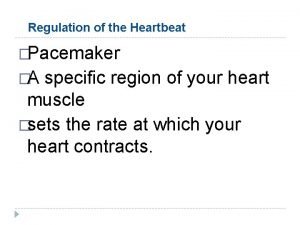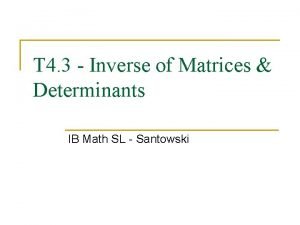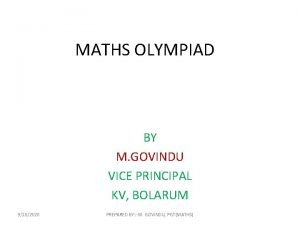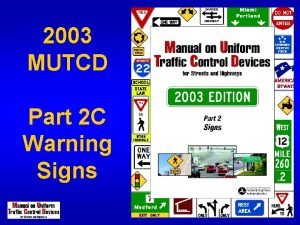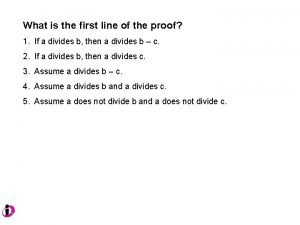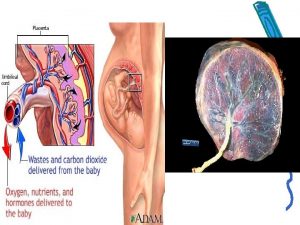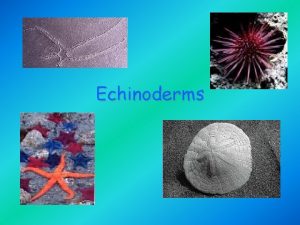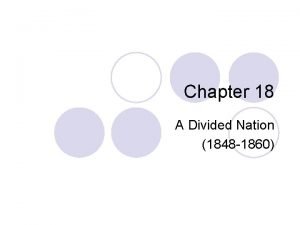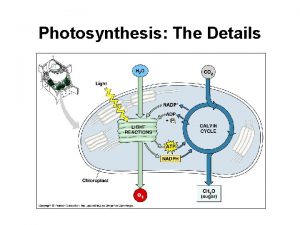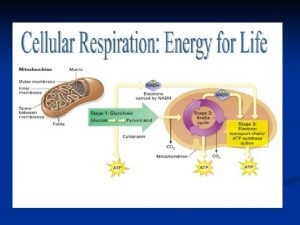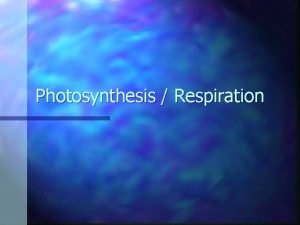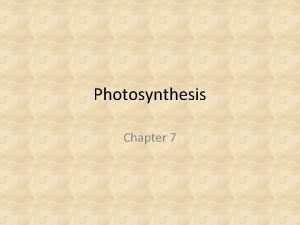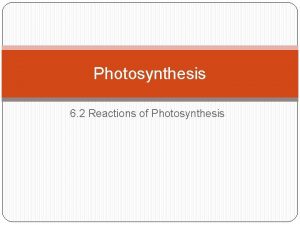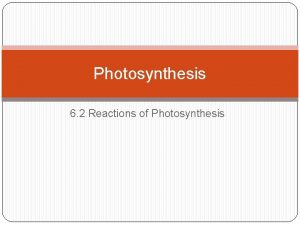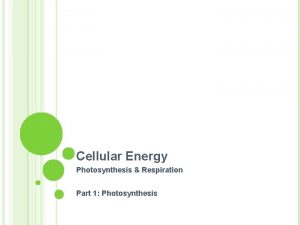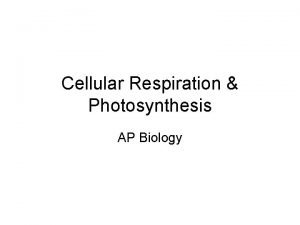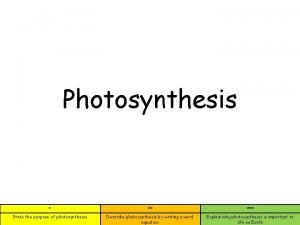3 3 Photosynthesis The Details Photosynthesis is divided



















































- Slides: 51

3. 3 Photosynthesis… The Details • Photosynthesis is divided into 2 sequential processes 1. Light reaction (stages 1 and 2) 2. Carbon Fixation (Calvin Cycle) (stage 3)

Overview of Photosynthesis 6 CO 2 + 12 H 2 O C 6 H 12 O 6 + 6 O 2 + 6 H 2 O • Photosynthesis, like cellular respiration, is a series of redox reactions!

Tracking Atoms in Photosynthesis… Reactants 6 CO 2 Products C 6 H 12 O 6 12 H 2 O 6 O 2

What does this suggest about photosynthesis? The sugars that result from photosynthesis are produced by adding the hydrogen ions and electrons from water to carbon dioxide, NOT by splitting CO 2 and adding water! oxidized H+ and e- 6 CO 2 + 12 H 2 O C 6 H 12 O 6 + 6 O 2 + 6 H 2 O reduced

The stages of photosynthesis… Light Dependent Reactions • Occurs along the thylakoid membrane • this is where H 2 O is oxidized. • chemiosmotic production of ATP! • electron carrier (NADPH) is synthesized

Light Reaction • Divided into 3 parts; 1. Photoexcitation-absorption of a photon by an electron of chlorophyll 2. Photosystems and the ETC 3. Chemiosmosis (sound familiar? )

Photoexcitation • Before photons strike chlorophyll, their electrons are at ground state (lowest potential energy) • Once the photon strikes the electron it becomes “excited” and moves to a higher potential energy level • The electron eventually goes back to ground state (loss of potential energy appears as heat and light-fluorescence if it is not used in photosynthesis)


Photoexcitation • Most chlorophyll do not fluoresce while in a thylakoid memebrane b/c the excited electron is captured by the primary electron acceptor • This is a redox rxn-the chlorphyll is oxidized and the primary acceptor is reduced


Photosystems and the ETC

ETC of Photosynthesis Chloroplasts transform light energy into chemical energy of ATP u generates O 2 use electron carrier NADPH

Photosystem Photon PETC

Photosynthetic Electron Transfer Chain (PETC) • series of electron carriers which take electrons from photosystem, and. . • ultimately carry electrons to NADP+

Photosystems • Experiments in the 1940’s suggested that light photons are absorbed at 2 different points along the same PETC. … • In fact, there are two Photosystems in operation

chlorophyll a ETC of Photosynthesis Photosystem II chlorophyll b Photosystem I

ETC of Photosynthesis sun 1 e e Photosystem II P 680 chlorophyll a

Inhale, baby! ETC of Photosynthesis thylakoid chloroplast + +H+ H H+ + H+ H+H +H+ H H H+ ATP + +H+ H H+ + H H+ H+ HH SPLIT water! H H 1 e- e e Photosystem II P 680 chlorophyll a fill the e– vacancy e- H+ +H OO H H e e O 2

ETC of Photosynthesis thylakoid chloroplast H+ + +H+ H H+ + H H+ H+ HH + +H+ H H+ + H+ H+H H H H e e ATP 3 2 1 e e H+ 4 ATP H+ H+ H+ Photosystem II P 680 chlorophyll a H+ to Calvin Cycle H+ H+ H ADP + Pi ATP H+ H+ energy to build carbohydrates

e e ETC of Photosynthesis e e c an – e e 5 fil e e Photosystem II P 680 chlorophyll a e h lt Photosystem I P 700 chlorophyll b e c va y sun

ETC of Photosynthesis e e electron carrier 6 e e 5 Photosystem II P 680 chlorophyll a Photosystem I P 700 chlorophyll b $$ in the bank… reducing power! N Cal ADPH vin Cyc to sun le

ETC of Photosynthesis sun e e sun O split H 2 O H+ + H+ H + H+ +H H+ H+ H to Calvin Cycle ATP

Terms • Primary electron acceptor-pheophytin (PSII) • PQ-Plastoquinone (PSII) • Z protein-splits water (PSII) the 2 electrons are used to replace the ones lost in P 680, oxygen leaves as “waste” and the protons remain adding to the gradient • B 6 -f cytochrome complex (PSII) • Pc-Plastocyanin (PSII) • Fd-ferredoxin (PSI) • NADP reductase (PSI) uses 2 electrons and H+ to reduce NADP+ to NADPH (b/c 2 electrons are needed this process must occur twice) • ATP is created by chemiosmosis due to the proton gradient in the thylakoid lumen-this drives ATP synthase. 4 protons are move into the lumen for each pair of electrons that move through the ETC

ETC of Photosynthesis • ETC uses light energy to produce – ATP & NADPH (called noncyclic electron flow) • go to Calvin cycle • PS II absorbs light – excited electron passes from chlorophyll to “primary electron acceptor-pheophytin” – need to replace electron in chlorophyll – Enzyme (z protein) extracts electrons from H 2 O & supplies them to chlorophyll • splits H 2 O (h protons) • O combines with another O to form O 2 • O 2 released to atmosphere • and we breathe easier!

Noncyclic Photophosphorylation • Light reactions elevate electrons in 2 steps (PS II & PS I) – PS II generates energy as ATP – PS I generates reducing power as NADPH ATP

Cyclic photophosphorylation • If PS I can’t pass electron to NADP…it cycles back to PS II & makes more ATP, but no NADPH – coordinates light reactions to Calvin cycle – Calvin cycle uses more ATP than NADPH 18 ATP + 12 NADPH 1 C 6 H 12 O 6 ATP

Photophosphorylation cyclic photophosphorylation NADP NONcyclic photophosphorylation ATP

Light reactions • Electron Transport Chain • like in cellular respiration – proteins in organelle membrane – electron acceptors • NADPH – proton (H+) gradient across inner membrane • find the double membrane! – ATP synthase enzyme thylakoid chloroplast + +H+ H H+ + H+ H+H +H+ H H ATP + +H+ H H+ + H+ H+H H H H

Photosynthesis summary Where did the energy come from? Where did the electrons come from? Where did the H 2 O come from? Where did the O 2 go? Where did the H+ come from? Where did the ATP come from? What will the ATP be used for? Where did the NADPH come from? What will the NADPH be used for? …stay tuned for the Calvin cycle

Practice Questions • Q 1 -8 p. 166

The stages of photosynthesis… Light Independent Reactions-Calvin Cycle • Occurs in the stroma of the chloroplast. • Where CO 2 is “fixed” into sugars!

Whoops! Wrong Calvin… The Calvin Cycle

Remember what it means to be a plant… • Need to produce all organic molecules necessary for growth – carbohydrates, lipids, proteins, nucleic acids • Need to store chemical energy (ATP) produced from light reactions – in a more stable form – that can be moved around plant – saved for a rainy day carbon + water + energy glucose + oxygen dioxide 6 CO 2 + 6 H 2 O + light C 6 H 12 O 6 + 6 O 2 energy

Light reactions • Convert solar energy to chemical energy ATP – ATP energy – NADPH reducing power • What can we do now? build stuff !! photosynthesis

How is that helpful? • Want to make C 6 H 12 O 6 – synthesis – How? From what? CO 2 are available? What raw materials NADPH carbon fixation NADP C 6 H 12 O 6 reduces CO 2 NADP

From CO 2 C 6 H 12 O 6 • CO 2 has very little chemical energy – fully oxidized • C 6 H 12 O 6 contains a lot of chemical energy – highly reduced • Synthesis = endergonic process – put in a lot of energy • Reduction of CO 2 C 6 H 12 O 6 proceeds in many small uphill steps – each catalyzed by a specific enzyme – using energy stored in ATP & NADPH

From Light reactions to Calvin cycle • Calvin cycle – chloroplast stroma • Need products of light reactions to drive stroma synthesis reactions – ATP – NADPH thylakoid

C Calvin cycle 1 C C C 3. Regeneration C C C of Ru. BP starch, sucrose, cellulose & more ribulose bisphosphate 3 ATP H H H | | | C–C–C C C C C CO 2 5 C Ru. Bis. Co glyceraldehyde-3 -P G 3 P 3 C C 6 NADP 6 C PGA phosphoglycerate C C C 3 C C C C C 6 ATP 2. Reduction 6 NADPH 1. Carbon fixation C C C ribulose bisphosphate carboxylase 3 ADP used to make glucose C=C=C 5 C C C 3 C 6 ADP H | H |

Remember G 3 P? glycolysis glucose C-C-C-C 2 ATP 2 ADP fructose-1, 6 b. P P-C-C-C-P DHAP P-C-C-C G 3 P glyceraldehyde 3 -phosphate C-C-C-P 2 NAD+ 2 4 ADP Photosynthesis pyruvate C-C-C 4 ATP

To G 3 P and Beyond! • Glyceraldehyde-3 -P – end product of Calvin cycle – energy rich 3 carbon sugar – “C 3 photosynthesis” • G 3 P is an important intermediate • G 3 P glucose carbohydrates lipids phospholipids, fats, waxes amino acids proteins nucleic acids DNA, RNA

Ru. Bis. Co • Enzyme which fixes carbon from air – ribulose bisphosphate carboxylase – the most important enzyme in the world! • it makes life out of air! – definitely the most abundant enzyme

Accounting • The accounting is complicated – 3 turns of Calvin cycle = 1 G 3 P – 3 CO 2 1 G 3 P (3 C) – 6 turns of Calvin cycle = 1 C 6 H 12 O 6 (6 C) – 6 CO 2 1 C 6 H 12 O 6 (6 C) – 18 ATP + 12 NADPH 1 C 6 H 12 O 6 – any ATP left over from light reactions will be used elsewhere by the cell

Photosynthesis summary • Light reactions – produced ATP – produced NADPH – consumed H 2 O – produced O 2 as byproduct • Calvin cycle – consumed CO 2 – produced G 3 P (sugar) – regenerated ADP – regenerated NADP

Light Reactions light ATP + NADPH + O 2 energy H 2 O + H 2 O sunlight Energy Building Reactions NADPH ATP O 2 § produces ATP § produces NADPH § releases O 2 as a waste product

Calvin Cycle CO 2 + ATP + NADPH C 6 H 12 O 6 + ADP + NADP CO 2 ADP NADP Sugar Building Reactions NADPH ATP sugars § builds sugars § uses ATP & NADPH § recycles ADP & NADP § back to make more ATP & NADPH

Putting it all together light CO 2 + H 2 O + energy C 6 H 12 O 6 + O 2 H 2 O CO 2 sunlight ADP Energy NADP Building Reactions Sugar Building Reactions NADPH ATP O 2 sugars Plants make both: § energy § ATP & NADPH § sugars

even though this equation is a bit of a lie… it makes a better story sun Energy cycle Photosynthesis light CO 2 + H 2 O + energy C 6 H 12 O 6 + O 2 plants CO 2 H 2 O glucose animals, plants ATP C 6 H 12 O 6 + O 2 energy + CO 2 + H 2 O Cellular Respiration The Great Circle of Life, Mufasa! ATP O 2

Summary of photosynthesis 6 CO 2 + 6 H 2 O + light C 6 H 12 O 6 + 6 O 2 energy • • • Where did the CO 2 come from? Where did the CO 2 go? Where did the H 2 O come from? Where did the H 2 O go? Where did the energy come from? What’s the energy used for? What will the C 6 H 12 O 6 be used for? Where did the O 2 come from? Where will the O 2 go? What else is involved…not listed in this equation?

Supporting a biosphere • On global scale, photosynthesis is the most important process for the continuation of life on Earth – each year photosynthesis… • captures 121 billion tons of CO 2 • synthesizes 160 billion tons of carbohydrate – heterotrophs are dependent on plants as food source for fuel & raw materials

The poetic perspective… • All the solid material of every plant was built by sunlight out of thin air • All the solid material of every animal was built from plant material air Then all the plants, cats, dogs, elephants & people … are really particles of air woven together by strands of sunlight! sun

Practice Questions • Q 9 -13 p. 166
 Major details and minor details
Major details and minor details Major detail and minor detail
Major detail and minor detail Thiếu nhi thế giới liên hoan
Thiếu nhi thế giới liên hoan Fecboak
Fecboak Chúa yêu trần thế alleluia
Chúa yêu trần thế alleluia điện thế nghỉ
điện thế nghỉ Một số thể thơ truyền thống
Một số thể thơ truyền thống Sơ đồ cơ thể người
Sơ đồ cơ thể người Công thức tiính động năng
Công thức tiính động năng Số nguyên tố là
Số nguyên tố là đặc điểm cơ thể của người tối cổ
đặc điểm cơ thể của người tối cổ Tỉ lệ cơ thể trẻ em
Tỉ lệ cơ thể trẻ em Các châu lục và đại dương trên thế giới
Các châu lục và đại dương trên thế giới ưu thế lai là gì
ưu thế lai là gì Tư thế ngồi viết
Tư thế ngồi viết Thẻ vin
Thẻ vin Môn thể thao bắt đầu bằng từ chạy
Môn thể thao bắt đầu bằng từ chạy Cái miệng bé xinh thế chỉ nói điều hay thôi
Cái miệng bé xinh thế chỉ nói điều hay thôi Hình ảnh bộ gõ cơ thể búng tay
Hình ảnh bộ gõ cơ thể búng tay Từ ngữ thể hiện lòng nhân hậu
Từ ngữ thể hiện lòng nhân hậu Trời xanh đây là của chúng ta thể thơ
Trời xanh đây là của chúng ta thể thơ Tư thế ngồi viết
Tư thế ngồi viết Thế nào là giọng cùng tên? *
Thế nào là giọng cùng tên? * Chó sói
Chó sói Thể thơ truyền thống
Thể thơ truyền thống Hươu thường đẻ mỗi lứa mấy con
Hươu thường đẻ mỗi lứa mấy con Thế nào là hệ số cao nhất
Thế nào là hệ số cao nhất Diễn thế sinh thái là
Diễn thế sinh thái là đại từ thay thế
đại từ thay thế Ng-html
Ng-html Vẽ hình chiếu vuông góc của vật thể sau
Vẽ hình chiếu vuông góc của vật thể sau 101012 bằng
101012 bằng Thế nào là mạng điện lắp đặt kiểu nổi
Thế nào là mạng điện lắp đặt kiểu nổi Mật thư anh em như thể tay chân
Mật thư anh em như thể tay chân Lời thề hippocrates
Lời thề hippocrates Vẽ hình chiếu đứng bằng cạnh của vật thể
Vẽ hình chiếu đứng bằng cạnh của vật thể Chụp tư thế worms-breton
Chụp tư thế worms-breton Quá trình desamine hóa có thể tạo ra
Quá trình desamine hóa có thể tạo ra Sự nuôi và dạy con của hổ
Sự nuôi và dạy con của hổ Các châu lục và đại dương trên thế giới
Các châu lục và đại dương trên thế giới Dot
Dot Bổ thể
Bổ thể Thế nào là sự mỏi cơ
Thế nào là sự mỏi cơ Phản ứng thế ankan
Phản ứng thế ankan 300 divided by 12
300 divided by 12 Determinant matrice 3x3
Determinant matrice 3x3 Determine which of the two numbers 3111 or 1714 is larger
Determine which of the two numbers 3111 or 1714 is larger Mutcd no outlet sign
Mutcd no outlet sign A divides b
A divides b Divided into three categories
Divided into three categories Echinoderm means spiny skin
Echinoderm means spiny skin A divided nation section 1
A divided nation section 1












































